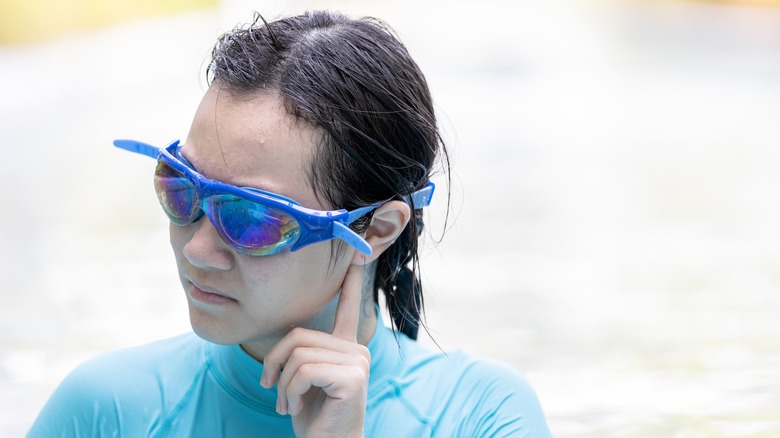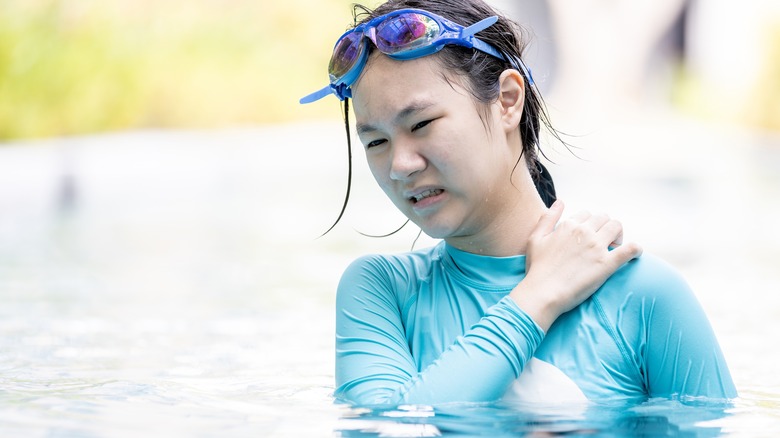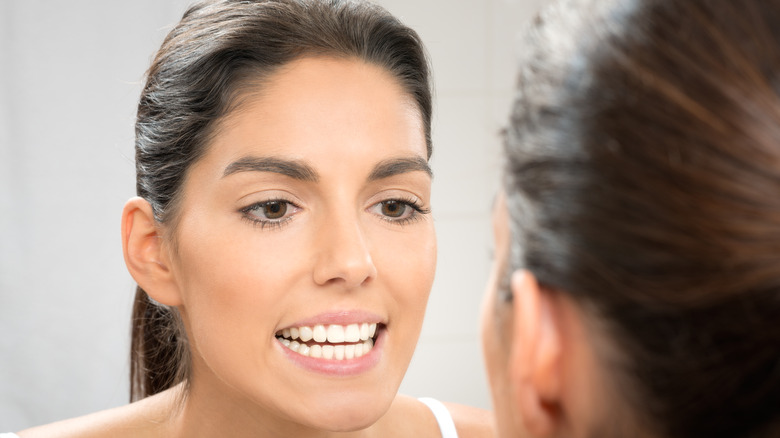9 Gross Things You Can Catch From Swimming In A Pool This Summer
Who doesn't love to take a dip when it heats up outside? Summer is prime swim season, and it's a great time of year to cool down in the water, either at the hotel pool during your next vacation or at the neighborhood or community pool. Unfortunately, this popular warm-weather pastime doesn't come without its fair share of risks. While you shouldn't necessarily dive into the water expecting to emerge with a problem, it is possible to catch something unwelcome when you swim.
Those communicable risks range from rashes and earaches to digestive troubles and fungal infections. While the promise of going for a swim in the sweltering heat can be appealing, it's just smart practice to be mindful of what could possibly develop in the aftermath. The reasons are clear. People carry with them many different types of germs and bacteria, all of which can infiltrate the water and potentially cause others to get sick. All kinds of culprits could be to blame, including dead skin cells, sweat, hair, spit, sunblock, and even excrement (yes, really).
As horrible as it sounds, the harsh truth is that health concerns can arise if you unknowingly swallow or breathe in any of these unwelcome contaminants. Knowledge is power, though, and once you're aware of the risks, you can be more mindful about pool risks for you and your loved ones — and take the right steps if you suspect you've contracted a possible water-related malady post-swim.
Bacteria in the pool water could cause swimmer's ear
When bacteria and water enter your ear, the result could be the dreaded swimmer's ear. This can cause a whole host of uncomfortable symptoms, including swelling, irritation, and itchiness. As the moisture lingers in the ear canal, it creates a hospitable place for bacteria and germs to thrive and the infection to become more widespread. If you have any recollection of the ear infections you may have suffered as a child, then you might have a general idea of what swimmer's ear feels like.
The discomfort can significantly affect your quality of life, Courtney Voelker, MD, PhD, of the Pacific Neuroscience Institute, tells SELF. "The skin is literally laying on the bone," she explains. "When there is any swelling between the bone and skin, it pulls the skin away from the bone, and that can be extremely painful."
So, what should you do if you suspect you've got swimmer's ear? The first step is to see your doctor for a comprehensive ear examination to rule out anything else. They'll typically prescribe ear drops (often with antibiotics), and may recommend that you take an over-the-counter painkiller to manage your discomfort as you heal. To prevent future infections, consider wearing a bathing cap or earplugs when you swim. It's also a good idea to dry your ears thoroughly after you're done. If you suspect there's water in your ears, use a hair dryer to dry out the canals.
Cryptosporidium germs in the pool could cause diarrhea
It may be a word that's new to you, but if you plan to spend any time at all in the pool, it's smart to be aware of cryptosporidium. This germ can cause digestive distress, in particular watery diarrhea that lingers for up to two weeks. Also known as crypto, it's especially pervasive because it can survive even in a filtered pool for as long as 10 days. Unfortunately, symptoms can take anywhere from a couple of days to 10 days to develop.
Medical toxicologist Kelly Johnson-Arbor, M.D., explains to VeryWell Health, "If one person with Cryptosporidium gets into a pool, it can lead to days or even weeks of exposures for many, many people." Given that you can't exactly see crypto, it may seem impossible to avoid it — but that's not exactly the case. One way to protect yourself is to test the water's pH level yourself. It should measure between 7.2 and 7.8. You can also perform a search to see if the pool has a history of crypto problems, or if there are any recent records reported.
If you do choose to swim without being totally sure of the water's crypto status, be careful not to swallow the water. And if you do contract the illness, drink fluids to combat diarrhea-related dehydration. You can also take anti-diarrheal medication, but consult with your doctor beforehand to ensure that it's safe. Individuals with compromised immune systems may require additional treatment.
Walking around the pool barefoot could lead to athlete's foot
You don't need to be an actual athlete to develop athlete's foot. This common fungal infection is often contracted by walking in a communal pool area barefoot. Worse, if you have even a microscopic cut on your foot, it could become a prolonged problem that causes everything from deeper cracks to intense itching. While it typically affects the skin between the toes, it can also spread to the tops, soles, and heels.
Pool environments are doubly risky because the infection can spread from one person's contaminated towel to another towel. You can protect yourself by steering clear of others' belongings, and by wearing some type of footwear, like flip flops or sandals, when you walk around the pool. You can usually self-treat athlete's foot, explains podiatrist Mohammad Rimawi to NBC News. "Look for a treatment that contains clotrimazole, which has good efficacy against a wide spectrum of fungi that cause athlete's foot. This ingredient has been available for a long time and is well studied."
As footwear expert Gabriel Miller shares (via Birmingham Live), "Walking barefoot exposes you to pathogens like plantar warts, athlete's foot, and ringworm, which thrive in these conditions. These organisms can easily invade small cuts or abrasions on unprotected feet, leading to uncomfortable and sometimes serious infections." If the infection becomes more invasive, it could lead to symptoms like pus and foul odor.
If you swim this summer, you could develop chlorine rash
You may be surprised to learn that chlorine can cause irritation to your skin if you've never had a problem in the pool before. After all, the chemical is vital to killing off potentially harmful contaminants that could otherwise cause health problems. While the American College of Allergy, Asthma, and Immunology states that people don't actually develop allergies to chlorine, some people can be especially sensitive to the chemical.
The itchiness, redness, and tenderness can strike at any time, and it's actually a type of dermatitis. Moreover, chlorine can be drying, so even if you don't develop an allergic reaction, you may simply feel the discomforts associated with parched skin. If you already have dermatitis, you may experience a worsening of your symptoms after exposure to chlorine. The problem is actually due to the reaction that occurs when chlorine mixes with water, explains dermatologist Ife J. Rodney, M.D. to Prevention. "This acid can open the pores, breaking down the skin's natural oils and moisture barrier, causing dryness. The longer you stay in the water, the worse it gets."
Because pools may have varying levels of chlorine, you may not notice a rash every time you swim in a different pool. Some, like public pools and hotel pools, may have more chlorine. To prevent a chlorine rash or to minimize the discomfort, take a shower immediately after swimming and apply a gentle, unscented moisturizer. See a dermatologist if the rash lingers.
Recreational water illness could develop after swimming
People don't typically associate the term "recreation" with illness, but it's wise to be alert to potential water-based problems that might occur if you plan to swim in a pool this summer. Also known as RWIs, recreational water illnesses occur when people come into contact with water that is in some way contaminated. This includes swallowing or even inhaling just a bit of the water. Examples include norovirus, E.coli, and respiratory health problems.
Pool water can easily become contaminated when a person with diarrhea goes swimming. Even the most minuscule amount could cause significant contamination thanks to the countless germs it contains. And because so many people likely use the same pool, it's very possible for the RWI to spread across a great number of those people if the water is not properly disinfected and has less than 1.0 parts per million (ppm) of chlorine at all times (per Aqua Magazine).
Typically, people with RWIs are most likely to develop diarrhea as the primary symptom. However, it's possible for other unwelcome effects to emerge, including nausea, vomiting, cramping, and weight loss. Not all RWIs cause the same symptoms; some can even lead to skin, respiratory, or vision problems. You can safeguard yourself from getting an RWI by showering immediately after you swim and doing your best not to swallow the water. If you have diarrhea, it's best to stay out of the pool entirely until you recover.
If you swim, you might catch molluscum contagiosum skin infection
Molluscum contagiosum is a viral skin infection that can affect people of any age, but is most common among children and adults who are immunocompromised in some way. Typically spread through contaminated water, it can cause pinkish bumps to develop. While it's not painful, molluscum contagiosum is very contagious and has the potential to last for years if left untreated.
This is why it's crucial to act quickly if you discover the spots on your child or yourself. Known as mollusca, the spots feel firm, remain uniform in size and appearance, and don't go away on their own. While symptoms are typically mild, untreated spots could become inflamed and even fill with pus. Dermatologist Anar Mikailov, MD, FAAD, explains to PopSugar that the infection is often spread via common objects and public spaces. "Bath towels, swimming pools, and Turkish baths have all been reported as sources of infection," he says.
While people with robust immune systems might not require treatment for molluscum contagiosum, those who have some types of dermatitis, like psoriasis and eczema, or whose symptoms are especially disruptive will benefit from medical intervention. These treatments may include topical creams, liquid nitrogen application, or laser treatment for especially stubborn cases. The good news is that once a child is infected, they're unlikely to contract the infection again, Andrea Zaenglein, M.D., tells Parents.
Chlorine in pool water could turn your teeth yellow
It's not a commonly known side effect, but chlorine has the potential to discolor your teeth — specifically, turning them either brown or yellow. Luckily, this is only likely to be a problem if you spend six or more hours in the water. For this reason, it's unlikely that you'd experience a problem with only casual summer visits to the pool. However, if you're a competitive swimmer or just love your pool time, you should know about this possible and unwelcome cosmetic problem.
Because the chlorinated pool water's pH is greater than that of your saliva, the protective proteins on the teeth gradually wear away. Discoloration isn't the only effect that chlorine causes on teeth, either. With enough exposure to the water, it's possible for enamel to erode. This can have a long-term detrimental effect, as worn-down enamel leaves teeth vulnerable to cavity formation and sensitivity.
Luckily, there are steps you can take to protect your teeth if you plan to spend a significant amount of time in the water. The first is to brush your teeth before you go for a swim. This will prevent the chemicals in the pool water from clinging to your teeth and potentially causing yellowing and enamel erosion. Make sure that you rinse out your mouth after you're done, too, either with water or a fluoride-base oral rinse. Avoid brushing, as the scrubbing could be too rough on your enamel right after exposure to the chlorine.
You could pick up Legionnaires' disease in the pool
Caused by exposure to Legionella, a type of germ, Legionnaires' disease is a lung infection that can lead to a wide range of symptoms that extend beyond chest pain, difficulty breathing, and coughing. People may also develop body aches, headaches, nausea, fever, and even cognitive decline. This is more likely to occur among kids and adults who have compromised immune systems. While the germ is more commonly found in hot tubs than pools because pool water is usually on the cooler side, it is not unheard of, either; if the water is warm enough (between 77 and 113 degrees Fahrenheit), it's certainly a possibility.
According to the National Health Service, it's possible to contract Legionnaires' disease by breathing in droplets of infected water. In addition to those with compromised immune health, people who are over 50 years of age, people who smoke, and those who have respiratory health concerns are all at increased risk of developing the disease. While generally rare, Legionnaires' disease is thought to affect some 25,000 people throughout the United States yearly (per New York State).
If you experience any symptoms associated with Legionnaires' disease, it's important to see a doctor for a prompt examination. They'll take chest X-rays and may order urine cultures and phlegm tests to determine whether you have pneumonia. The most common treatment for the disease is a course of antibiotics, with some people requiring hospitalization to make a complete recovery.
Damp pool environments could lead to ringworm
Ringworm (sometimes referred to as tinea) is a kind of fungal infection that can develop in moist environments where the fungi thrive. Leading to itchy, unsightly, and highly uncomfortable rashes, this condition can occur anywhere on the body, and may not even develop until two weeks after exposure. While anyone can contract ringworm if they're exposed to the fungus, it's more likely to infect people with compromised immune systems and those who have hyperhidrosis, a condition that causes excessive sweating. This said, ringworm is an extremely common infection, largely because it's so contagious. You don't even need to make physical contact with an infected person; just touching something that belongs to them could be enough.
The most common symptom is a reddish, ring-like rash with raised borders. Over time, the ring begins to expand in size, while the center portion continues to look fairly unaffected. The condition can also occur on the scalp, where small black specks may appear in areas where hair strands break away. You can avoid contracting ringworm by wearing protective footwear, like flip flops or sandals, when you walk around the pool. You should also avoid sharing towels or clothing with others.
According to Aaron Glatt, an infectious diseases doctor at Mount Sinai South Nassau Hospital, ringworm is manageable. "Usually, these infections are not life-threatening and can be treated with various over-the-counter creams or lotions," he tells Fox News. "Serious infection, however, may require prescription antifungal medications."










